Pieces of History
Raised from the deep, the Monitor’s turret reveals a bounty of new details about the ship’s violent end
Sixteen miles off north Carolina’s Cape Hatteras and 240 feet beneath the surface of the Atlantic, the ocean bottom was as gray, pocked and silent as the moon. Harbor Branch Oceanographic Institution’s Johnson-Sea-Link II submersible slowed, and pilot Don Liberatore turned on its sonar. A thick smudge of white light pulsed like a heartbeat on the readout, growing bigger by the second. “It’s coming up right now,” Liberatore said. He toggled a switch, light flooded the void, and the chiseled bow of the USS Monitor, the Civil War’s most celebrated ship, appeared on the screen.
Liberatore steered the sub over the Monitor’s forward section, a wreckage of iron plates and frames that once composed the officers’ and captain’s quarters. Here, beneath a dim skylight 140 years ago, acting assistant paymaster William F. Keeler wrote to his wife, Anna, describing life aboard “our iron monster.” Here, too, in the wardroom, commissioned officers shared meals, debated politics and discussed their innovative little ironclad’s next assignment in a war that was tearing the young United States apart.
The sub moved slowly farther aft and hovered next to a 9-foot-tall, 22-and-a-half-foot-wide revolving turret, the first in naval history. Schools of small orange fish called red barbiers flitted about the iron cylinder. “I feel like I can reach out and touch it,” said John Broadwater, his voice rasping in the sub’s headphones. An underwater archaeologist and manager of the Monitor National Marine Sanctuary, Broadwater was among the first to explore the wreck after it was discovered by scientists aboard Duke University’s vessel Eastward, in 1973, and has since championed the effort to recover parts of it. He has guided the five-year partnership between the National Oceanic and Atmospheric Administration, which oversees the sanctuary, and the U.S. Navy, whose divers have retrieved the ship’s propeller, engine and hundreds of other artifacts. This past summer, the team went for the turret itself. In July, Navy divers discovered that the two 11-inch Dahlgren cannons had not dropped out of the turret, as some historians speculated, when the Monitor sank on December 31, 1862, landing upside down on the ocean floor. They also learned that at least two members of the crew who were lost on that “night of horrors,” as Keeler put it, died in the turret itself, their last and only refuge from the storm-lashed sea.
The union navy brought out the Monitor on January 30, 1862, amid much skepticism. “We heard every kind of derisive epithet applied to our vessel—she was called a ‘silly experiment,’ an ‘iron coffin for her crew’ & and we were styled fool hardy for daring to make the trip in her, & this too by navy men,” wrote Keeler. Designed by Swedish-American inventor John Erics-son, the Monitor was a hodgepodge of components never before joined: steam power, iron construction, a revolving turret. Resembling a 173-foot-long black lozenge, it looked more like a submarine than a surface warship. The flat deck cleared the water by only 14 inches when the ship was loaded. In the middle sat the gigantic and ungainly turret, shaped like a pillbox.
For centuries, the vagaries of wind and current had played a major role in all naval battles. Wooden sailing ships jockeyed with each other for hours or even days, trying to come up broadside so they could engage their guns with maximum effectiveness. The Monitor changed all that. With its iron construction designed to deflect enemy fire, and its 400-horsepower steam engine, the Monitor eliminated traditional ships’ two major weaknesses: a vulnerability to cannon shot and restricted maneuverability. But the revolving turret was by far the Monitor’s most enduring innovation. Armed only with two 16,000-pound cannons, the turret was built of eight layers of inch-thick iron bolted together and seated in a brass ring. Two small auxiliary engines called donkey engines rotated the turret, enabling the Monitor to fire upon an enemy no matter where the ship was situated.
This past summer, broadwater and a crew of U.S. Navy divers were camped out on the 300-foot derrick barge Wotan, anchored off the North Carolina coast. Working in teams around the clock, 7 days a week for 41 days, 162 divers had readied the Monitor’s turret for bringing it to the surface, cutting, hammering and dredging their way through tons of concreted coral, coal and sediment to clear the turret’s interior. When the capsized Monitor sank to the seafloor, a coal scuttle landed on top of the turret, filling it with tons of coal the crew had bunkered just before leaving the Chesapeake. At this depth, the surface-supplied divers had at most 40 minutes before they had to begin the 70-minute climb to sea level, stopping at way points so that their bodies could slowly get rid of accumulated nitrogen that can cause the debilitating and sometimes fatal diving sickness known as the bends. Once they’d finished their last stop at 40 feet, they had only five minutes to swim to the surface, climb onto the barge’s deck—where the team stripped off their 175 pounds of gear—and get into the onboard decompression chamber for up to two more hours.
All that’s risky enough, but nearby were the cowboys who ride even wilder ponies—saturation divers, who don’t return to sea level for up to ten days. In teams of two they worked on the wreck for 12 hours, then climbed into a diving bell pressurized at 230 feet. Winched back from the depths onto the barge, the bell was joined to a cluster of huge, white decompression chambers where the divers could safely eat, sleep and live for the duration of their ten-day shift. Life under pressure is uniquely dangerous, even for ordinary activities. A tiny air bubble in a cough drop can create a vacuum that will suck the lozenge against a diver’s tongue or mouth with remarkable force, leaving a painful ulcer. And returning to sea level was a 66-hour trip through another chamber.
Which is why they love it, of course. “Out of the Blue, Into the Black,” read one diver’s T-shirt, quoting Neil Young, who probably never considered his lyric quite so literally. Pound for pound, there was enough testosterone on the Wotan this summer to supply Viagra Nation. These divers are the front line for maritime disasters of all stripes, from the crash of twa Flight 800 to the terrorist attack on the USS Cole. They dive on wrecks where they can barely see and the bodies still have faces.
All that hard work paid off. They recovered the glass hydrometers that 25-year-old, first-class fireman George Geer would have used to measure the salinity of seawater intended to fill the ship’s boilers, and mustard and pepper bottles used to spice up the bland Navy food. They found bones. The coal and sediment had preserved them remarkably well. “We found fully articulated skeletal remains,” says Wayne Lusardi, museum conservator at the Mariners’ Museum in Newport News, Virginia. “Buttons were found at the wrists, down the thoracic cavity, near the waist.” The dead sailor had carried a knife in his right front pocket; it was found resting on his right femur, enclosed within some wool fabric. Archaeologists believe the knife may yield some clues to the sailor’s identity. Later, they found a second skeleton. These remains are being treated as mias, and they have been sent to the Army’s Central Identification Laboratory in Hawaii, where forensic anthropolo- gists are working to identify them.
Says Cmdr. Bobbie Scholley, commanding officer of the Navy’s Mobile Diving and Salvage Unit Two and head of this expedition’s dive operations, “We feel connected to the sailors, because we’re bringing them home.”
After seeing his iron home for the first time, Keeler wrote to Anna that “your better half will be in no more danger from rebel compliments than if he was seated with you at home.” It was kind reassurance for a lonely wife. But the Union Navy was in a terrible hurry, for the Confederates had just unveiled a secret weapon, and haste would almost undermine the Monitor. In April 1861, the Confederates occupied the Navy Yard at Hampton Roads in Virginia and salvaged the Union warship Merrimack, which had been scuttled nearby. They refitted her with steam engines, sheathed her topsides in iron and armed her with ten guns, renaming her the CSS Virginia. (Union sailors refused to call the ship by its Confederate name, and many historians perpetuated that insult well into the 20th century. To this day, most people still refer to her as the Merrimack.) The Virginia represented a serious threat to Union ships blockading the entrance to Hampton Roads, which ensured them access to northern supply routes in the Atlantic and in the Chesapeake Bay. The Union commanders feared that their blockading ships wouldn’t stand a chance against the fortified Virginia. They needed backup in a hurry.
By September, Union officials had approved a design. It took only another four months to build the Monitor. With a complement of 11 officers and 48 men, the ship set out March 6, 1862, from the Brooklyn Navy Yard in New York, bound for the Chesapeake Bay and the Virginia. A day into the voyage, the seas rose and the wind started blowing furiously. The Monitor started leaking. Water poured down through the turret on top of George Geer, who was fighting a cold and had been trying to rest in his hammock on the berth deck. Paymaster Keeler looked up from his writing desk and saw waves washing over his small skylight. Water flooded the stubby blower pipes, soaking the belts that drove the ventilators. Toxic fumes from the coal-fired boilers felled men where they stood, and their mates carried fallen soldiers to the top of the turret for fresh air. Without sufficient draft, the boilers began shutting down, leaving barely enough power to run the pumps.
It was an inauspicious—and nearly fatal—beginning for the Union Navy’s experiment and a portent of the ship’s fate. But when the storm blew itself out, the Monitor and her exhausted crew were still afloat. Within three days after leaving New York, they arrived in Hampton Roads in time to witness the Virginia’s horrifying handiwork that day: the 50-gun frigate Congress lay burning and would soon explode; the sloop Cumberland had been rammed and then sunk; the steam frigate Minnesota sat grounded and useless off Newport News.
The next morning, March 9, 1862, the Monitor steamed over to the Union vessel Minnesota, whose crew members were frantically throwing whatever they could get their hands on overboard in an attempt to lighten her and free her keel. The Virginia approached the Minnesota, intent on finishing her off. At first, the Confederate sailors paid little attention to the Monitor, which was half the Virginia’s length and sat low in the water. But when the Monitor’s second cannon-shot solidly hit the Virginia, the battle of the ironclads was joined. Hurling shot, sometimes from a range of only 20 feet, the two ships pummeled each other for four hours.
But it soon became clear that the Monitor’s guns were not capable of delivering a deathblow to the Virginia. The guns’ designer, Capt. John A. Dahlgren, had expressed some concerns about the integrity of the untested cannons, so Lt. John L. Worden, the Monitor’s captain, had ordered his gunners to load only one charge of gunpowder per firing. Later tests showed these cannons could have handled three charges, and historians have speculated that, had they done so, the Monitor would have severely damaged or even sunk the Confederate vessel. As it was, the cannon only cracked several iron plates. As for the Monitor’s vaunted turret, at first it wouldn’t turn at all, because the drenching ride south had rusted the control wheel. Even when Chief Engineer Alban Stimers cleared the rust, he found the turret difficult to control or stop in time for an accurate shot.
Still the Monitor had made its point. The Virginia’s balls had pocked and dented the turret—one vicious hit knocked unconscious two men inside. But the Monitor’s eight inches of armor and ability to fire from any position had proved its tactical worth. Safe within the ship, none of the crew was seriously hurt; only Worden was badly injured when he peered from the pilothouse just as a shell exploded. “Our ship resisted everything they could fire at her as though they were spit balls,” Geer wrote to his wife, Martha.
History would call the battle a stalemate, but by thwarting the Virginia’s efforts to sink the blockading fleet, the Monitor had preserved the Union’s strategically important control of the Chesapeake Bay. From President Lincoln to ordinary citizens, no one could get enough of the little ship. Lincoln visited the vessel shortly after the battle and on other occasions during the spring and summer. Even Nathaniel Hawthorne visited the ship. “People seem to regard her as a sort of irresistable war monster & anyone arriving from her as something more than human,” Keeler wrote. The men of the Monitor were heroes, bearers of their tormented nation’s right stuff.
It was an early morning in August 2002, and the metal deck of the Wotan was beginning to bake. Inside the gray metal container that served as the Navy dive team’s command center, Scholley, Chief Warrant Officer Rick Cavey and John Broadwater anxiously watched video monitors showing divers working 240 feet below. A cold front was coming from the northwest and a tropical depression spun to the south, either of which might suspend diving and put a disappointing end to the $14 million project after five long years of effort. In four days, funds would be exhausted.
The divers had already centered a 25-ton, eight-legged grappling claw called the Spider over the turret and lowered a platform next to it. With the turret safely embraced in the Spider’s clutch, what remained was to attach eight shackles and lifting straps to the legs; raise the turret and place it on the platform; anchor the Spider to the platform with turnbuckles and more shackles; and then lift the whole thing.
That was the plan. But for the past three days rough water and strong bottom currents had made it impossible. By the next day, the approaching front would turn this unforgiving stretch of water into a maelstrom of 30-knot winds and six-foot seas. Broadwater and Scholley had been considering the possibility of coming home empty-handed. It was now or never.
About 7 a.m., divers headed down to the site and started attaching the 135-pound lifting shackles. Though the surface was calm, the bottom current remained “at the edge of the margins,” said Cavey. One of Cavey’s divers found that the only way to fight the current was to stab his knife into the seabed and pull himself along.
The sound of the ragged breathing of the divers filled the combox, a small speaker broadcasting the communication among the divers below the surface. When they talked, either to each other or to colleagues on the surface, they sounded like Donald Duck, due to the special mix of oxygen and helium they breathed.
Near the combox, a support team of 22 additional divers listened and waited. A fully suited diver sat heavily in a chair, ready to go below at a hint of trouble. Another, dressed only in running shorts, boots and tattoos, kept his eyes riveted on the panel that controlled the gas mix that the divers breathed. Several oversaw the umbilicals, a series of hoses that supplied the divers with air, communication and warm water, which was continuously pumped through their suits. Another diver kept time, checking a series of stopwatches slung around his chest like bandoliers.
On the sea bottom, saturation diver Chief Petty Officer Keith Nelson, along with two other divers, wrestled the last shackle into place. “That’s it!” he said. Then Nelson helped the operator of the Wotan’s 500-ton crane gently pluck the dislodged turret from the sea bottom. As it began to separate, the three divers found themselves in a total blackout as sediment swirled around them. When the current finally swept the bottom clear, the crane slowly moved the Spider over the platform. Slight swells at the surface turned the 235-ton load into an underwater wrecking ball: slamming downward, it left four-inch indentations in the platform’s three-eighths-inch-thick steel plate. Finally, the crew got the platform attached, and the lift began. When the Monitor’s turret broke the water’s surface, starfish and coral fell off, and seawater sluiced out its gunports and over the clearly visible dents that the Virginia’s cannonballs had inflicted 140 years ago. Broadwater stood momentarily speechless before joining the rest of the barge in stentorian war whoops of victory.
Two months after the battle of the ironclads, the Union took the port of Norfolk. The Confederates grounded the Virginia, set her on fire and let 18 tons of powder in her magazine make sure that not one rivet would go to the Union cause. Her nemesis gone, the Monitor sailed up the James River to spend a tedious, sweltering summer shadowing Union Gen. George McClellan’s abortive peninsula campaign. “I have charge of the Thurmomitor,” Geer wrote to Martha on June 13, “and found in my store room, which is farthest astern, it stood at 110; in the engine room 127; in the galley ...155; on the berth deck where we sleep 85.”
For the sailors, poor ventilation ranked high on a long list of complaints. In October, the Monitor arrived in Washington, D.C. and underwent several weeks of refitting, but then she rushed to Hampton Roads again, this time to join two other monitor-class ironclads ordered to take Wilmington, North Carolina. On Monday, December 29, the Monitor left the Chesapeake under tow by the side-wheel steamer Rhode Island.
Tuesday morning a storm started brewing. By nightfall, the Monitor was taking the rough water head-on. “The heavy seas rolled over our bows dashing against the pilot house &, surging aft, would strike the solid turret with a force to make it tremble,” Keeler wrote to Anna. The pounding soon took a toll and waves began sweeping the turret. Water—the Monitor’s most relentless enemy—started filling the ship. “I staid by the pump untill the water was up to my knees and the cylinders to the pump engines were under water and stoped,” Geer wrote. “She was so full of water and roled and pitched so bad I was fearfull she would role under and forget to come up again.” By the time he and the last dozen men got to the turret—the only way to reach the deck—the Monitor was sinking. They saw the Rhode Island’s boats coming to take them off.
“It was a scene well calculated to appall the boldest heart,” Keeler wrote. “Mountains of water were rushing across our decks & foaming along our sides.” As the men climbed down the turret and crawled toward the boats, the sea snatched at least two of them and swept them to their deaths. The rescue boats smashed against the ship’s side, the wind howled and the men screamed into the roaring blackness. “The whole scene lit up by the ghastly glare of the blue lights burning on our consort, formed a panorama of horror which time can never efface from my memory,” Keeler wrote. Geer jumped from the turret and made for a boat just as a wave swept the man next to him overboard. “As soon as the Wave had passed over ...this time reached the Boat and was Saved, and I can tell you I would not like to try it over again.” After shedding most of his clothes, Keeler tried to climb down the turret but found the ladder stacked with terrified sailors. He slid down a line hanging from one of the turret awning’s stanchions, and a wave immediately swept him across the deck, slamming him into a lifeline stanchion. “I grasped with all the energy of desperation,” he wrote, and he pulled himself along the ship deck’s lifelines until at last he reached a boat and was hauled aboard.
Atop the turret, a single lantern burned red. Just before 1 a.m., as the last boat left the Rhode Island to retrieve the remaining men, the light went out. The Monitor, along with 16 men, was gone.
Inside the turret, the only smell is of the sea. Coral clings to the metal shell. The one-and-a-quarter-inch-thick bolts that hold the iron sheets together look like gigantic rusty polka dots. The dents made by the Virginia’s cannon are the diameter of a soccer ball. Wooden blocks with hanks of rope lying in their sheaves hang as if still waiting for a hand to turn them. Ramrods and other tools used by the gunners are scattered about. As soon as the turret was raised, archaeologists found the second skeleton. “They were lying very close together near one of the hatches in the turret’s roof,” says Broadwater. Preliminary excavation also found fragments of a wool overcoat, rubber buttons with “U.S. Navy” inscribed on them, a comb made of India rubber and, from one of the sailors’ pockets, a silver serving spoon with an engraved design on it.
The turret arrived August 10 at the Mariners’ Museum in Newport News, Virginia, where all of the artifacts recovered from the Monitor are undergoing conservation, and was immediately immersed in an 86,000-gallon conservation tank. Thermometers, bottles and lantern chimneys; gimballed lantern holders graced with ornate Victorian filigree; bilge pump parts and ladders; the 36-ton engine encrusted with marine life—all bathe in a variety of containers, from small tubs to construction-size Dumpsters, where a cocktail of chemicals slowly removes the corrosive salts that have permeated the metal parts.
It will take months for archaeologists to finish the excavation of the turret and discern its secrets. And it will be years—an estimated 12 to 15—before the metal of the turret will be stable enough to be removed from the conservation tank so it can be displayed for public viewing at the soon-to-be-built USS Monitor Center at the museum.
Meantime, Broadwater and his team will try to find a way to return to the ship. They want to stabilize what remains of the hull and perhaps explore some of its forward sections, where William Keeler wrote his long letters and the officers of the Monitor raised toasts to their doughty little ship. Now on the ocean floor, what’s left of the Monitor rests quietly, perhaps with more stories yet to tell.
Wendy Mitman Clarke’s book, Window on the Chesapeake, is due out in 2003. Lynda Richardson photographed desert biologist Pinau Merlin in December 2001.
/https://tf-cmsv2-smithsonianmag-media.s3.amazonaws.com/accounts/headshot/WendyClarke1.JPG)
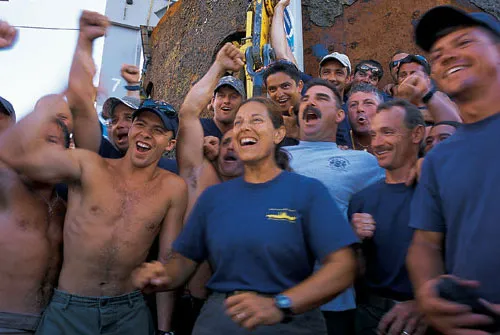
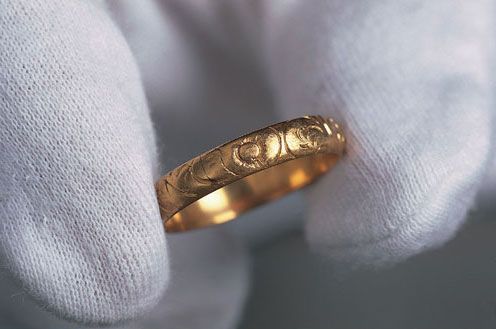
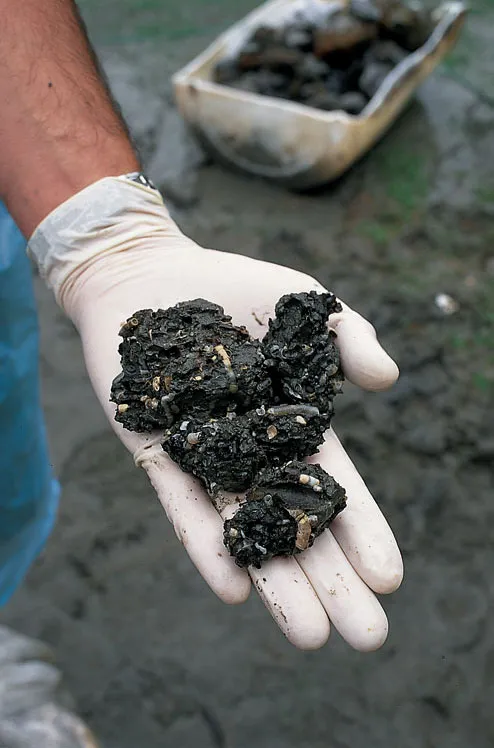
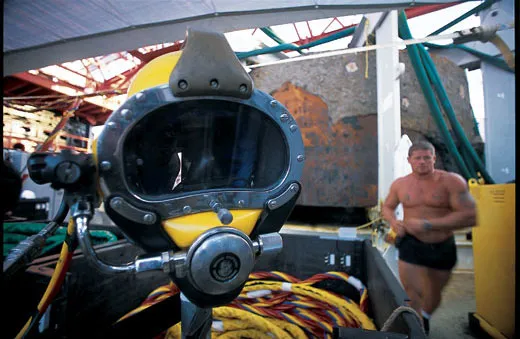
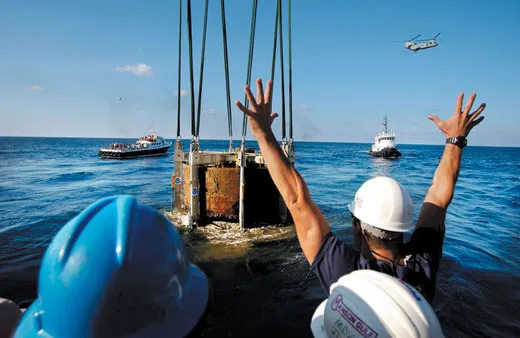
/https://tf-cmsv2-smithsonianmag-media.s3.amazonaws.com/accounts/headshot/WendyClarke1.JPG)